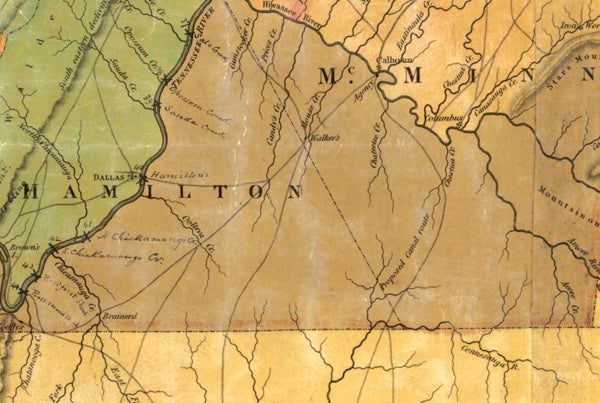The canal that nearly changed Tennessee history
Published 1:10 pm Tuesday, December 14, 2021
|
Getting your Trinity Audio player ready...
|
By Bill Carey
Tennessee’s eighth grade students learn about the Erie Canal — the artificial body of water that connected the Hudson River to the Great Lakes. They also learn that the Erie Canal is largely responsible for making New York the largest city in America. America’s “canal era” bypassed Tennessee. But a canal very nearly changed our state’s history.
The Conasauga River is the only river in Tennessee that is not part of the Mississippi, Tennessee or Cumberland River systems. It flows west through the southeast Tennessee counties of Polk and Bradley, then turns south into Georgia. From there the Conasauga River merges with two larger rivers, and eventually flows into Mobile Bay and the Gulf of Mexico.
Before manmade dams were built in the twentieth century, there were many barriers to navigation on the Tennessee River. Downstream from present-day Chattanooga was a series of rapids and currents with names like the Suck, Frying Pan and Boiling Pot. A hundred miles further along the Tennessee River there was an even worse series of barriers known as the Muscle Shoals.
While all of this may make sound like a kayaker’s paradise, the boatmen who transported goods along the Tennessee River by flatboat and raft didn’t see it that way. In fact, the barriers to navigation along the Tennessee River were so bad that they retarded the commercial growth of the eastern part of the state.
East Tennessee merchants were always looking for alternatives to the long, dangerous trek down the Tennessee River, all the way to the Ohio and Mississippi rivers and to New Orleans. In 1821, some keelboat operators tried a different route. They began taking the Tennessee River downstream to the Hiwassee, then the Hiwassee upstream to the Ocoee, then the Ocoee upstream to a point five miles south of present-day Benton. Boats and cargo were then lifted onto wagons and dragged nine miles south, where they were lowered onto the Conasauga for the long journey to Mobile Bay.
For about a generation, products such as flour and whiskey were moved with regularity through the portage (which, by the way, passed through Cherokee territory). The route, though an interesting alternative, was not efficient enough from a commercial point of view. In fact, no sooner did it start becoming used than talk began of a canal connecting the Ocoee and Conasauga rivers.
In 1826, the Tennessee General Assembly granted a charter to the Hiwassee Canal Company, whose intent was to develop the canal. About that time, Tennessee Gov. Joseph McMinn petitioned Congress to obtain the permission of the Cherokee Nation to build the canal.
The U.S. War Department sent two engineers to survey a potential canal. The men determined that the route was feasible and said 15 locks would be needed — 10 on the Ocoee side and five on the Conasauga.
Had the Ocoee-Conasauga canal been built, East Tennessee might have grown a lot more prior to the Civil War. Bradley and Polk counties would almost certainly have larger cities today.
However, the canal was never created. One reason was President Andrew Jackson’s lack of enthusiasm for internal improvements financed by the federal government. But the main reason appears to have been the opposition of the Cherokee Nation. Allowing goods to be transported through their land was one thing; selling land for a canal was another. When asked to sell the land through which the canal would be dug, Cherokee chiefs rejected the notion.
During the 1830s, matters related to the Cherokee were centered on the Indian Removal Act and the tragic Trail of Tears that followed. By the time the Cherokee left, railroads were taking over America. The Ocoee-Conasauga canal was never dug.
Today, the Ocoee is known for whitewater rafting. The Conasauga River is notable for the biodiversity of its freshwater life. But it is unknown to most Tennessee residents. In fact, there is supposed to be a fountain at the Bicentennial Capitol Mall State Park for every river in the state. I say “supposed to be” because there isn’t one for the Conasauga River — the “ignored” body of water that nearly changed Tennessee history.






